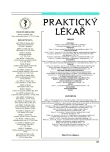Complications in the treatment of diabetic foot syndrome using total contact cast, with a focus on osteomyelitis
Authors:
V. Fejfarová; A. Jirkovská; R. Bém; M. Křížová; V. Šindelářová; P. Fexová; J. Skibová
Authors‘ workplace:
Centrum diabetologie, IKEM, Praha
přednostka prof. MUDr. T. Pelikánová, DrSc.
Published in:
Prakt. Lék. 2005; 85(6): 348-352
Category:
Therapy
Overview
One of the most suitable lower-limb off-loading methods used in diabetic foot treatment is total contact cast (TCC). TCC was not recommended in patients with osteomyelitis (OM).
The aims of our study were to assess the frequency of all complications and the effect of TCC therapy on healing of OM and on the risk of new OM development in patients with the diabetic foot. 61 patients with the diabetic foot treated for neuropathic foot ulcers, acute Charcot osteoarthropathy and neuropathic fractures by removable TCC were included into our study (mean age 54±9 years, diabetes duration 15.6±9 years, HbA1c 8.3±1.8 %). OM was diagnosed by X-ray and laboratory markers of infection. The rates of all complications were recorded over the study period of at least 2 months, maximum 12 months. The number of patients with OM before therapy and healed after TCC application was compared with the number of patients with newly developed OM during TCC therapy.
Results:
Removable TCC was applied for 5.4 ± 4.5 months on average in all patients. The most common complication of TCC therapy in the study group was broken cast (49 %), followed by the development of a new neuropathic ulcer on the same foot (25 %) however, these ulcers were not clinically important. Progression of local infection leading to discontinuation of TCC therapy was noted in 11 % of all patients.
Other complications such as joint pain (2 %) and mycosis (3 %) were seen very rarely. 21/61 (34 %) of all patients had OM before TCC therapy, 11/21 (52 %) of them healed during TCC treatment. 40/61 (66 %) of all patients had no diagnosed OM before TCC application; however, 3/40 (8 %) developed new OM during TCC treatment. The number of patients with healed OM was significantly higher compared with the number of patients with newly developed OM (p<0.01). 10 patients with previously diagnosed non-healed OM were characterized primarily by OM location (in tarsal bones). Other factors such as the type of ulcer and microbial resistance had no significant effect on OM healing during TCC therapy.
Conclusion:
Diabetic foot therapy with a special off-loading method using TCC has its inherent risks, particularly new ulcer development and progression of local infection. OM is not an absolute contraindication of TCC treatment, nevertheless local and X-ray findings must be monitored in these patients and antibiotic therapy instituted. Treatment of the diabetic foot by TCC should be managed by a foot clinic.
Key worlds:
osteomyelitis – diabetic foot – total contact cast.
Labels
General practitioner for children and adolescents General practitioner for adultsArticle was published in
General Practitioner

2005 Issue 6
Most read in this issue
- The principle of dual effect and conscience
- Defecography in the diagnostics of anorectal dysfunctions
- Clinical significance of vitamin K for quality of bone and for calcified tissues
- Atypical course of type A thoracic aortal dissection in a pregnant woman
